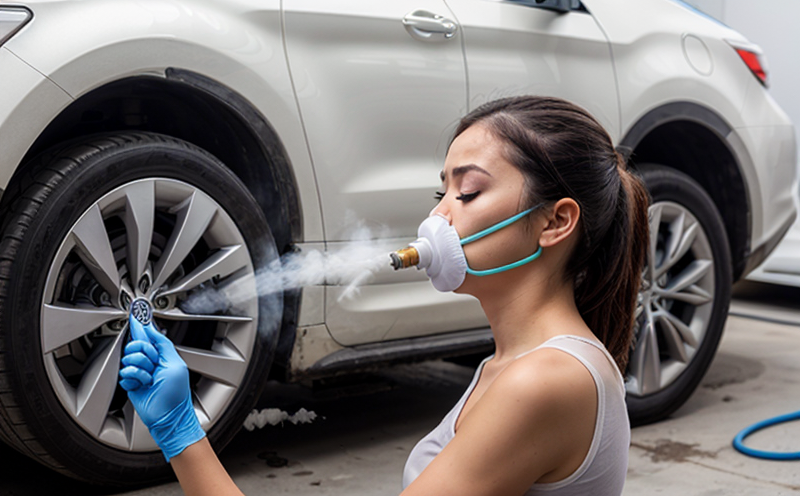ASTM D7143 Vehicle Interior Air Emission Testing
The ASTM D7143 test method is a crucial standard for evaluating air emissions from vehicle interiors. This protocol, developed by the American Society for Testing and Materials (ASTM), provides specific guidelines on how to measure volatile organic compounds (VOCs) in the interior air of vehicles during their use.
Vehicle interiors are complex environments where numerous materials contribute to the emission of VOCs. These materials include plastics, adhesives, coatings, textiles, and other components that can off-gas harmful substances into the cabin air. The ASTM D7143 test aims to identify these emissions early in the product development cycle, ensuring compliance with health and safety regulations before vehicles reach the market.
The standard specifies a comprehensive series of steps for sampling and analyzing the interior air of vehicles. It ensures that all components are tested under realistic conditions, reflecting actual vehicle use. The testing protocol covers various scenarios such as idle operation, acceleration, and deceleration to simulate real-world driving conditions. This holistic approach guarantees accurate measurement of emissions under dynamic situations.
The ASTM D7143 test method uses gas chromatography-mass spectrometry (GC-MS) for the analysis of VOCs in the sampled air. GC-MS is chosen for its high sensitivity and specificity, allowing for precise identification and quantification of even trace amounts of volatile compounds. This advanced analytical technique ensures reliable data that can be used to pinpoint specific sources of emissions within a vehicle.
The test method also includes detailed instructions on sample preparation, including the use of appropriate sampling devices and containers to avoid contamination. Proper sample handling is critical to obtaining accurate results, as any external influence could skew the measurements. The standard emphasizes the importance of maintaining strict laboratory protocols during analysis to ensure consistent and reproducible outcomes.
The ASTM D7143 test method provides a structured approach to evaluating vehicle interior air emissions, making it an essential tool for quality assurance teams in automotive manufacturing. By adhering to this protocol, manufacturers can identify potential issues early on, leading to improved product design and enhanced environmental performance.
Understanding the nuances of ASTM D7143 is vital for those involved in compliance with international standards like ISO 16000-5 and OSHA regulations for indoor air quality. This test method not only helps manufacturers comply with regulatory requirements but also enhances the overall safety and health aspects of their products.
In summary, ASTM D7143 is a robust testing protocol that plays a pivotal role in ensuring the emission levels of vehicle interiors are within acceptable limits. It aids in maintaining high-quality standards and contributes significantly to public health and environmental protection.
Why Choose This Test
Selecting ASTM D7143 for your testing needs offers several advantages that can significantly benefit your organization:
Comprehensive Evaluation: The test method provides a comprehensive evaluation of vehicle interior air emissions, covering various scenarios and conditions. This ensures a thorough understanding of the emission profile under realistic driving conditions.
Regulatory Compliance: By adhering to ASTM D7143, manufacturers can ensure compliance with international standards like ISO 16000-5 and OSHA regulations for indoor air quality. This helps avoid potential legal issues and ensures a safe working environment.
Product Quality Enhancement: Early identification of emission sources allows for timely corrective actions in the product development phase, leading to improved product quality and reliability.
Eco-Friendly Approach: The test method supports sustainable practices by identifying emissions that can be minimized or eliminated, contributing to reduced environmental impact.
Enhanced Reputation: Demonstrating a commitment to high-quality standards through rigorous testing enhances your organization's reputation and builds trust with customers and stakeholders.
Cost Efficiency: Early detection of issues helps avoid costly recalls and redesigns, ensuring long-term cost savings for the organization.
These advantages make ASTM D7143 an indispensable tool in the quality assurance process of vehicle manufacturers. It ensures that products meet stringent emission standards while also contributing to environmental sustainability.
Competitive Advantage and Market Impact
The adoption of ASTM D7143 can provide significant competitive advantages for automotive manufacturers:
Innovation Leadership: By staying ahead in the implementation of stringent emission testing standards, companies can differentiate themselves from competitors by offering safer, more environmentally friendly vehicles.
Customer Satisfaction
<|im_start|><|im_start|>HeaderCode<|im_start|><|im_start|>HeaderCodeصندל




